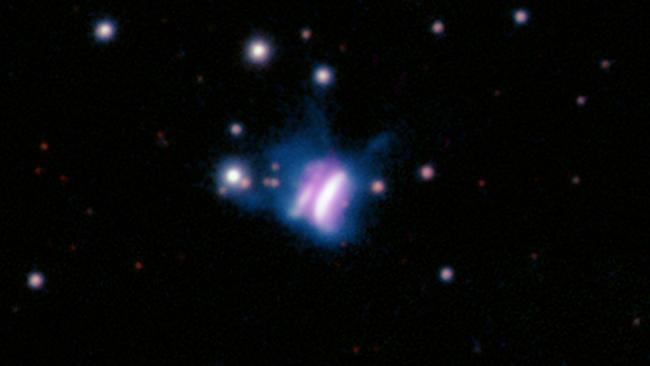CfA astronomers using the Submillimeter Array have determined the true nature of a "giant butterfly" in space, providing information about the environments where planets form.

Cambridge, MA--Astronomers have found what is likely the largest planet-forming disk ever seen, which appears like a giant, cosmic butterfly in the night sky. This discovery offers new insight into the environments where planets form.
Officially known as IRAS 23077+6707 (IRAS 23077, for short), this giant cosmic butterfly is about 1000 light-years from Earth and was initially discovered in 2016 by Ciprian T. Berghea from the US Naval Observatory using the Panoramic Survey Telescope and Rapid Response System (Pan-STARRS). However, for years it remained uncharacterized.
Two new papers have now revealed the true nature of IRAS 23077. One paper, led by Berghea and accepted for publication in The Astrophysical Journal Letters, reports the discovery that IRAS 23077 is a young star located in the middle of what looked like an enormous planet-forming disk. In the second paper, published yesterday in The Astrophysical Journal Letters, researchers confirm the discovery of a large planet-forming disk, using the Submillimeter Array (SMA).
The SMA is an array of telescopes in Hawaii jointly operated by the Smithsonian Astrophysical Observatory (SAO) at the Center for Astrophysics | Harvard & Smithsonian (CfA) and the Academia Sinica Institute of Astronomy and Astrophysics (ASIAA) in Taiwan. It detects light at millimeter wavelengths, a type of radio wave.
"After finding out about this possible planet-forming disk from Pan-STARRS data, we were keen to observe it with the SMA, which allowed us to understand its physical nature," explains Kristina Monsch, an SAO astrophysicist and a postdoctoral fellow at the CfA, who led the SMA campaign. "What we found was incredible – evidence that this was the largest planet-forming disk ever discovered. It is extremely rich in dust and gas, which we know are the building blocks of planets."
Planet-forming disks - called "protoplanetary disks" by astronomers - are planetary nurseries in which rocky planets like Earth and Mars, and giant planets like Jupiter and Saturn form around young stars. They are rich in dust and gas, and rotate with a specific signature that astronomers can use to infer their sizes, and the masses of their central stars.
Some planet-forming disks are 'edge–on,' meaning they are oriented such that their own dust and gas–rich disks entirely obscure the light emitted from their parent star, as is the case with IRAS 23077. While their stars may be shrouded, the dust and gas signatures of their surrounding disks can still be bright at millimeter wavelengths, as obtained by the SMA.
"The data from the SMA offer us the smoking–gun evidence that this is a disk, and coupled with the estimate of the system’s distance, that it is rotating around a star likely two to four times more massive than our own Sun," said Monsch. "From the SMA data we can also weigh the dust and gas in this planetary nursery, which we found has enough material to form many giant planets – and out to distances over 300 times further out than the distance between the Sun and Jupiter!."
"The discovery of a structure as extended and bright as IRAS 23077 poses some important questions," said co-author Joshua Bennett Lovell, an SAO astrophysicist and an SMA Fellow at CfA. "Just how many more of these objects have we missed? Further study of IRAS 23077 is warranted to investigate the possible routes to form planets in these extreme young environments, and how these might compare to exoplanet populations observed around distant stars more massive than our Sun."
"In addition to gaining brand new data on IRAS 23077, we must also continue the hunt for other similar objects if we are to unlock the story of how extrasolar planetary systems develop in their earliest years," said co-author Jeremy Drake, Astrophysics Chief Scientist at Lockheed Martin's Advanced Technology Center.
IRAS 23077 was initially termed "Dracula's Chivito" by Ciprian Berghea, who grew up in the Transylvania region in Romania, close to where Vlad Dracula lived. In analogy to the famous object “Gomez’s Hamburger”, which is another enormous planet-forming disk that is seen edge-on, they followed the suggestion of Ana Mosquera, Berghea's co-author, to name it after her country's national dish the "chivito," a hamburger-like sandwich from Uruguay.
Besides Kristina Monsch, Joshua Lovell, Jeremy Drake, and Ciprian Berghea, the authors of the ApJL paper are Gordian Edenhofer from the Max Planck Institute for Astrophysics, David J. Wilner, Garrett K. Keating, and Sean M. Andrews from CfA, and Ammar Bayyari from the University of Hawaii.
About the Center for Astrophysics | Harvard & Smithsonian
The Center for Astrophysics | Harvard & Smithsonian is a collaboration between Harvard and the Smithsonian designed to ask—and ultimately answer—humanity's greatest unresolved questions about the nature of the universe. The Center for Astrophysics is headquartered in Cambridge, MA, with research facilities across the U.S. and around the world.
Media Contact
Peter Edmonds
Interim CfA Public Affairs Officer
Center for Astrophysics | Harvard & Smithsonian
+1 617-571-7279
pedmonds@cfa.harvard.edu